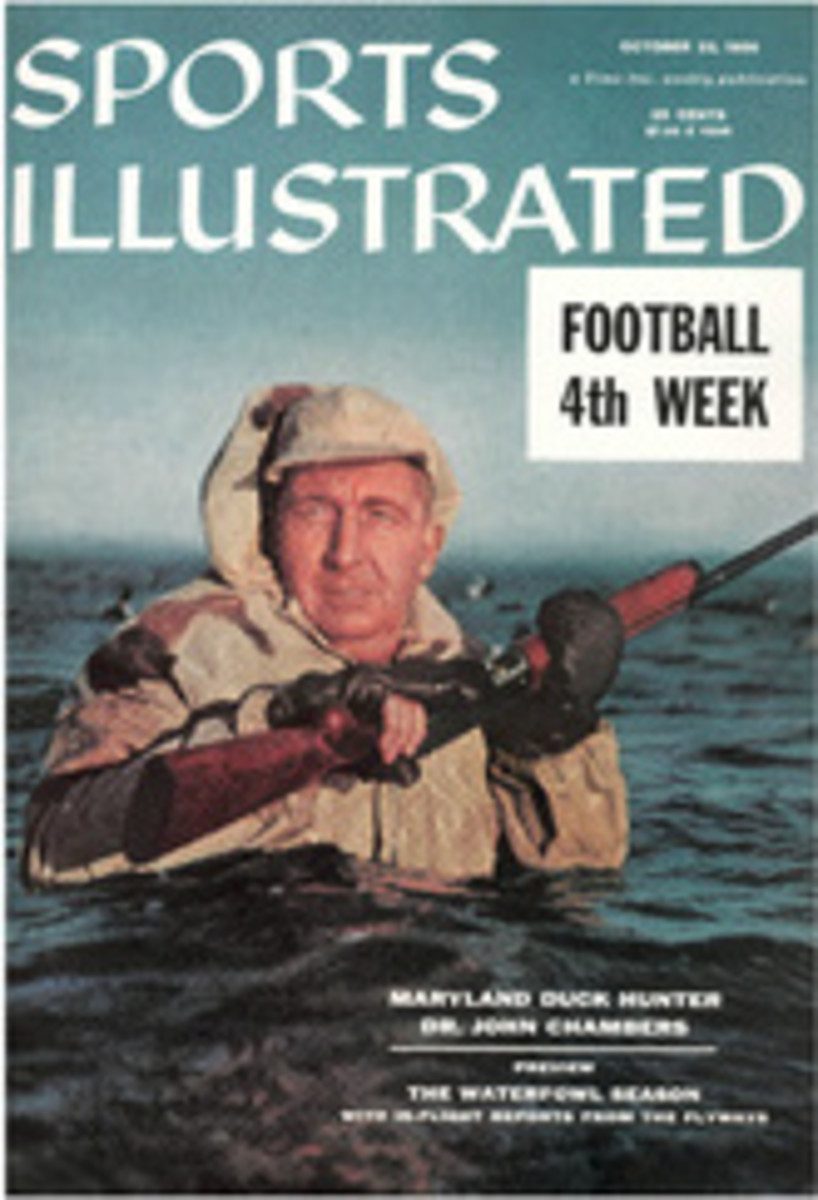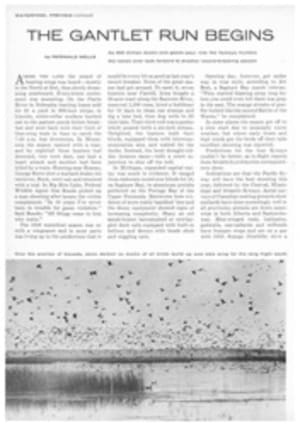
The Gantlet Run Begins
ACROSS THE LAND the sound of beating wings was heard—mostly in the North at first, then slowly drumming southward. Everywhere excitement was mounting. On the Platte River in Nebraska hunting leases sold for $1 a yard in 600-foot strips; in Lincoln, white-collar workers hurried out to the pasture ponds before breakfast and were back with their limit of blue-wing teals in time to catch the 7:45 a.m. bus downtown. In Minnesota the season opened with a roar, and by nightfall three hunters had drowned, two were shot, one had a heart attack and another had been killed by a train. Hunting near Roseau, George Bortz shot a mallard drake; his retriever, Buck, went out and returned with a teal. In Big Rice Lake, Federal Wildlife Agent Gus Bonde picked up a man shooting after hours; the victim complained: "In 10 years I've never been in trouble for game violation." Said Bonde: "All things come to him who waits."
The 1956 waterfowl season was on with a vengeance and in most parts was living up to the predictions that it would be every bit as good as last year's record breaker. News of the great season had got around. To meet it, seven hunters near Carroll, Iowa bought a 20-acre tract along the Raccoon River, removed 1,200 trees, hired a bulldozer for 12 days to clean out stumps and dig a lake bed, then dug wells to fill their lake. Their third well was a gusher which poured forth a six-inch stream. Delighted, the hunters built their blinds, equipped them with intercommunication sets, and waited for the ducks. Instead, the local drought-ridden farmers came—with a court injunction to shut off the well.
In Michigan, expanded capital outlay was much in evidence. It ranged from elaborate motel-size blinds for 10, on Saginaw Bay, to aluminum prefabs preferred on the Portage Bay of the Upper Peninsula. Retrievers bore evidence of more costly handlers' fees and the decoy equipment showed signs of increasing complexity. Many an old sneak-boater harrumphed at newfangled duck calls equipped with built-in bellows and decoys with heads abob and wiggling tails.
Opening day, however, got under way in true style, according to Art Best, a Saginaw Bay marsh veteran. "They started blasting away long before you could even tell there was gray in the east. The orange streaks of gunfire looked like the second Battle of the Marne," he complained.
In some places the season got off to a slow start due to unusually warm weather, but where early frosts and high winds got the birds off their tails excellent shooting was reported.
Predictions for the four flyways couldn't be better, as in-flight reports from SPORTS ILLUSTRATED correspondents show.
Indications are that the Pacific flyway will have the best shooting this year, followed by the Central, Mississippi and Atlantic flyways. Aerial surveys of Canadian nesting grounds show mallards have done exceedingly well in all provinces; pintails are down somewhat in both Alberta and Saskatchewan. Blue-winged teals, baldpates, gadwalls, canvasbacks and redheads have bumper crops and are on a par with 1955. Scaups (bluebills) show a marked increase, as do Canada geese. First to leave for the flight south were pintails, teals and buffleheads. The Pacific flyway may show a downward trend in pintails; Central and Mississippi flyways will have record flights with mallards predominating, and the forecast for the Atlantic flyway is "more scaups than usual."
Flights of waterfowl in western states are showing a moderate increase over last year. Dabbling ducks, especially pintails and baldpates, are in good supply, with mallards about the same as last year. Goose flights are as good as or better than last year.
California reports the best early season in years. There are heavy concentrations of pintails and other large ducks, and some geese, in the Tule Lake-Lower Klamath area, and waterfowl of all kinds are swarming into the central valleys—59% more than last year. An official census estimates there are 1,150,000 ducks and geese there. The Butte Sink, Colusa Refuge and Grizzly Island areas in the Sacramento Valley show heavy concentrations, as do the Mendota and Tulare lake areas of the San Joaquin Valley.
In Washington, good early hunting spots are the tideland areas and adjoining farmlands in the Skagit Flats, the potholes and marshes near Spokane and the coastal bays of Grays Harbor and Willapa. Goose hunting will be best in the eastern grainfields from mid-November to December 31.
The outlook for Nebraska is "better than ever." There have never been more ducks in the state than now, and some 200,000 hunters are afield. Southeast Nebraska is suffering somewhat from the dryness. Lake McConaughy, smack in the heart of the Central flyway, is providing excellent sport.
So far, the North Dakota season shapes up as one of the best on record. There are currently 2 to 4 million ducks in the state, and 1,000 geese, mostly Canadas, are on the Souris Refuge near Devils Lake.
Western Iowa hunters are enjoying good hunting in the Missouri River Valley. Best hunting seems to be in the Spirit Lake area. Most hunters were back home by 8 a.m. with the limit of four ducks each.
Conditions in Wyoming are the same as last year—good.
Idaho's major hunting areas are the Upper Snake River, Lower Snake valley and the Boise River. Early gunning is best in the vicinity of Idaho Falls. Hunting throughout the state should be best in mid-November.
Montana hunters will find best sport in the Flathead Valley area and the Missouri River Basin. Prospects in the east are only fair.
Oregon's top spots this year are the Willamette Valley, along lower Snake and Columbia rivers and in southern Oregon in the Summer Lake, Goose Lake and Klamath basins. Water conditions are improved, providing more space for hunters and birds.
Nevada's most important hunting areas are the marshes in the Fallon area and along the Colorado River in the Lake Mead vicinity. All species are abundant.
One of the heaviest concentrations in the mountain states is on the Bear River Refuge in Utah, where 633,000 ducks have been counted. Fall migration in this area is proceeding normally, and the Texas coast, which usually winters one to 3 million waterfowl, promises best hunting success.
First to arrive in the Southeast were the blue-wing teals, and some pintails have moved into central and southern Louisiana and the coastal areas of Maryland, Virginia and North Carolina. Food conditions are excellent in the Pin Oak Flats in the Mississippi flyway, and heavy concentrations of mallards are building up.
The New England states, and New York, Pennsylvania, New Jersey, Delaware and West Virginia should have good gunning seasons if the right weather prevails. Blue-and green-wing teals have arrived in the same numbers as last year, but black ducks are down.
Opening day turnout on Merrymeeting Bay in Maine was an estimated 5,000 hunters, and shooting space is hard to buy. Ducks are plentiful (estimated at 20,000 in bay) and scattered flocks of geese are being seen. The bay is holding a few remaining blue-and green-wing teals; and goldeneyes, blue-bills, ringnecks and pintails are migrating the length and breadth of the state. Jump shooters in the famed grounds of Allagash, St. John, Penobscot and Kennebec River watersheds report hot gunning and high bags.
That is how the 1956 waterfowl season shapes up as of now. Ducks and geese of all kinds are on the wing in record-breaking numbers, thanks largely to the year-round nesting groundwork of the sportsman-supported Ducks Unlimited organization. The success of the hunting season from now on depends on the weather, which must be foul to be good, and the skill of the individual hunter. If the weather cooperates, wildfowlers can look forward to a season as good, if not better, than ever before.
PHOTO
Over the prairies of Canada, skies darken as ducks of all kinds build up and take wing for the long flight south
MAP
  FLYWAY FORECAST
INCREASE
DECREASE
NO CHANGE
ATLANTIC FLYWAY
MAP
[See caption above.]
MISSISSIPPI FLYWAY
MAP
[See caption above.]
CENTRAL FLYWAY
MAP
[See caption above.]
PACIFIC FLYWAY

